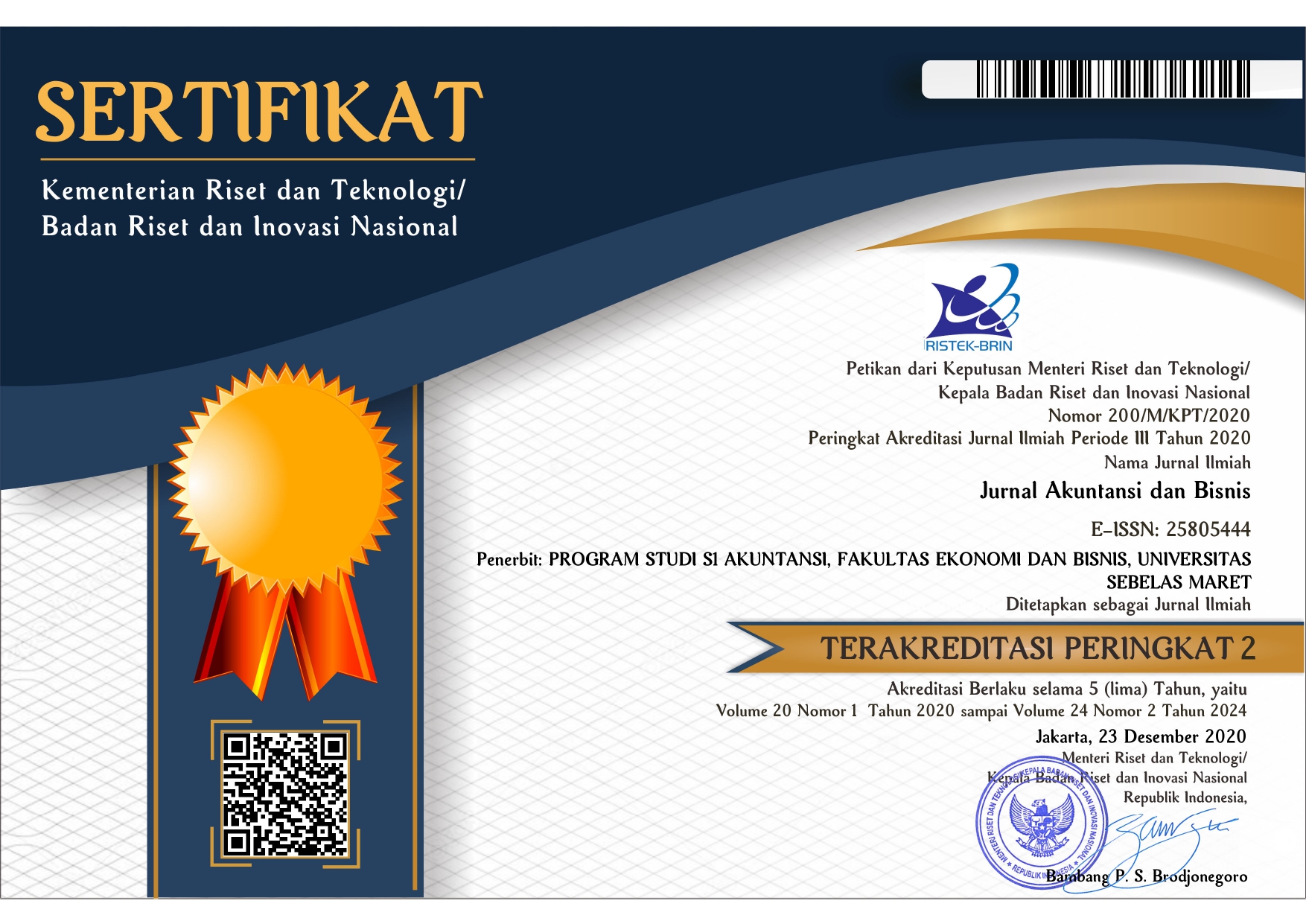Corporate Governance in The Dimension of Institutional Ownership Moderates Tax Avoidance
Abstract
Keywords
Full Text:
PDFReferences
Annuar, H. A., Salihu, I. A., & Obid, S. N. S. (2015). Corporate Ownership, Governance and Tax Avoidance: An Interactive Effects. Procedia - Social and Behavioral Sciences, 164(August), 150–160. https://doi.org/10.1016/j.sbspro.2014.11.063
Armstrong, C. S., Blouin, J. L., Jagolinzer, A. D., & Larcker, D. F. (2015). Corporate governance, incentives, and tax avoidance. Journal of Accounting and Economics, 60(1), 1–17. https://doi.org/https://doi.org/10.1016/j.jacceco.2015.02.003
Carolina, V., Natalia, M., & Debbianita. (2014). Karakteristik Eksekutif Terhadap Tax Avoidance Dengan Leverage Sebagai Variabel Intervening. Jurnal Keuangan Dan Perbankan, 18(3), 409–419.
Chaganti, R., & Damanpour, F. (1991). Institutional ownership, capital structure, and firm performance. Strategic Management Journal, 12(7), 479–491. https://doi.org/https://doi.org/10.1002/smj.4250120702
Chen, S., Chen, X., Cheng, Q., & Shevlin, T. (2010). Are family firms more tax-aggressive than non-family firms? Journal of Financial Economics, 95(1), 41–61. https://doi.org/https://doi.org/10.1016/j.jfineco.2009.02.003
Claessens, S., Djankov, S., & Lang, L. H. P. (2000). The separation of ownership and control in East Asian Corporations. In Journal of Financial Economics (Vol. 58, Issues 1–2). https://doi.org/10.1016/s0304-405x(00)00067-2
Desai, M. A., & Dharmapala, D. (2006). Corporate tax avoidance and high-powered incentives. Journal of FinDesai, M. A., & Dharmapala, D. (2006). Corporate Tax Avoidance and High-Powered Incentives. Journal of Financial Economics, 79(1), 145–179. Https://Doi.Org/Https://Doi.Org/10.1016/j.Jfineco.2005.02.002ancial Economics, 79(1), 145–179. https://doi.org/https://doi.org/10.1016/j.jfineco.2005.02.002
Dunbar, A., Higgins, D. M., Phillips, J. D., & Plesko, G. A. (2010). What do Measures of Tax Aggressiveness Measure ? National Tax Association Proceedings, 18–26.
Dyreng, S. D., Hanlon, M., & Maydew, E. L. (2010). The Effects of Executives on Corporate Tax Avoidance. The Accounting Review, 85(4), 1163–1189. https://doi.org/10.2308/accr.2010.85.4.1163
Fernández-Rodríguez, E., & Martínez-Arias, A. (2012). Do Business Characteristics Determine an Effective Tax Rate? Chinese Economy, 45, 60–83. https://doi.org/10.2753/CES1097-1475450604
Hanlon, M., & Heitzman, S. (2010). A review of tax research. In Journal of Accounting and Economics (Vol. 50, Issues 2–3). https://doi.org/10.1016/j.jacceco.2010.09.002
Jiang, Y., Zheng, H., & Wang, R. (2021). The effect of institutional ownership on listed companies’ tax avoidance strategies. Applied Economics, 53(8), 880–896. https://doi.org/10.1080/00036846.2020.1817308
Khan, M., Srinivasan, S., & Tan, L. (2016). Institutional Ownership and Corporate Tax Avoidance: New Evidence. The Accounting Review, 92(2), 101–122. https://doi.org/10.2308/accr-51529
Khurana, I., & Moser, W. (2009). Institutional Ownership and Tax Aggressiveness. SSRN Electronic Journal. https://doi.org/10.2139/ssrn.1464106
Kim, E. H., Lu, Y., Shi, X., & Zheng, D. (2020). How Does Stock Liquidity Affect Corporate Tax Avoidance? Evidence from China. Available at SSRN: Https://Ssrn.Com/Abstract=3409700 or Http://Dx.Doi.Org/10.2139/Ssrn.3409700. https://papers.ssrn.com/sol3/papers.cfm?abstract_id=3409700
Lim, Y. (2011). Tax avoidance, cost of debt and shareholder activism: Evidence from Korea. Journal of Banking and Finance, 35(2), 456–470. https://doi.org/10.1016/j.jbankfin.2010.08.021
Minnick, K., & Noga, T. (2010). Do corporate governance characteristics influence tax management? Journal of Corporate Finance, 16(5), 703–718. https://doi.org/https://doi.org/10.1016/j.jcorpfin.2010.08.005
Mintzberg. (1983). Power In and Around Organizations. Prentice-Hall; Englewood Cliffs, N.J.
Modigliani, F., & Miller, M. H. (1963). Corporate Income Taxes and the Cost of Capital : A Correction. The American Economic Review, 53(3), 433–443. https://doi.org/10.2307/1809167
Omer, T. C., Molloy, K. H., & Ziebart, D. A. (1993). An Investigation of the Firm Size—Effective Tax Rate Relation in the 1980s. Journal of Accounting, Auditing & Finance, 8(2), 167–182. https://doi.org/10.1177/0148558X9300800206
Phillips, J. D. (2003). Corporate Tax‐Planning Effectiveness: The Role of Compensation‐Based Incentives. The Accounting Review, 78(3), 847–874. https://doi.org/10.2308/accr.2003.78.3.847
Rego, S. O. (2003). Tax-Avoidance Activities of U . S . Multinational Corporations *. 20(4).
Rego, S. O., & Wilson, R. (2012). Equity Risk Incentives and Corporate Tax Aggressiveness. In Journal of Accounting Research (Vol. 50, Issue 3, pp. 775–810). John Wiley & Sons, Ltd (10.1111). https://doi.org/10.1111/j.1475-679X.2012.00438.x
Richardson, G., & Lanis, R. (2007). Determinants of the variability in corporate effective tax rates and tax reform: Evidence from Australia. Journal of Accounting and Public Policy, 26, 689–704. https://doi.org/10.1016/j.jaccpubpol.2007.10.003
Shinta, N. P., & Ahmar, N. (2011). Eksplorasi Struktur Kepemilikan Saham Publik Di Indonesia Tahun 2004 - 2008. The Indonesian Accounting Review, 1(02), 145–154. https://doi.org/10.14414/tiar.v1i02.42
Zimmerman, J. L. (1983). Taxes and firm size. Journal of Accounting and Economics, 5, 119–149. https://doi.org/https://doi.org/10.1016/0165-4101(83)90008-3
DOI: http://dx.doi.org/10.20961/jab.v23i2.1146
Jurnal Akuntansi dan Bisnis (JAB)
ISSN 1412-0852 (print), 2580-5444 (online)
Published by Accounting Study Program, Faculty of Economics and Business, Universitas Sebelas Maret, Indonesia

JAB on http://jab.fe.uns.ac.id/index.php/jab is licensed under a Creative Commons Attribution-ShareAlike 4.0 International License










